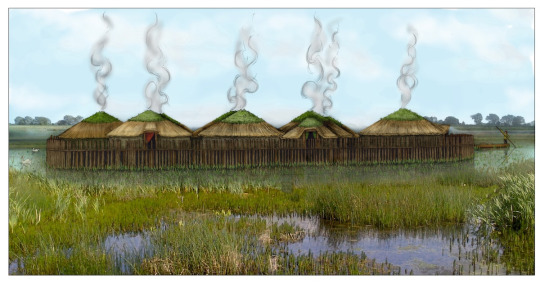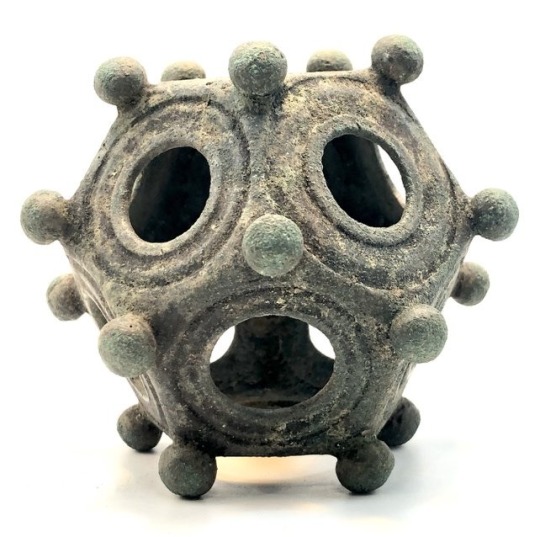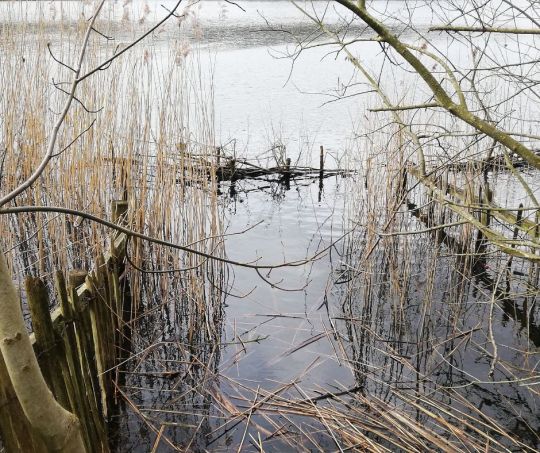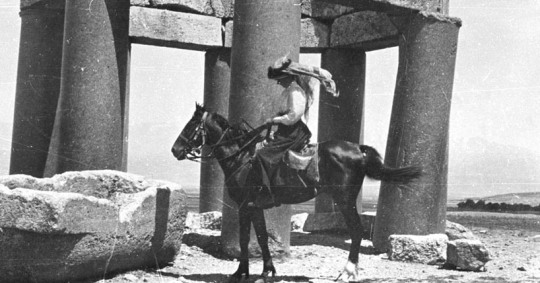#UK archaeology
Text
WOW.
Scientists found an amazingly well-preserved village from 3,000 years ago


Text below, in case article access dries up:
LONDON — A half-eaten bowl of porridge complete with wooden spoon, communal rubbish bins, and a decorative necklace made with amber and glass beads are just a handful of the extraordinarily well-preserved remnants of a late Bronze Age hamlet unearthed in eastern England that’s been dubbed “Britain’s Pompeii” and a “time capsule” into village life almost 3,000 years ago.
The findings from the site, excavated in 2015 to 2016, are now the subject of two reports, complete with previously unseen photos, published this week by University of Cambridge archaeologists, who said they cast light onto the “cosy domesticity” of ancient settlement life.
“It might be the best prehistoric settlement that we’ve found in Britain,” Mark Knight, the excavation director and a co-author of the reports, said in an interviewThursday. “We took the roofs off and inside was pretty much the contents,” he said. “It’s so comprehensive and so coherent.”
The reason for the rare preservation: disaster.
The settlement, thought to have originally consisted of several large roundhouses made of wood and constructed on stilts above a slow-moving river, was engulfed by a fire less than a year after being built.
During the blaze, the buildings and much of their contents collapsed into a muddy river below that “cushioned the scorched remains where they fell,” the university said of the findings. This combination of charring from the fire and waterlogging led to “exceptional preservation,” the researchers found.
“Because of the nature of the settlement, that it was burned down and its abandonment unplanned, everything was captured,” Knight added.
“As we excavated it, there was that feeling that we were picking over someone else’s tragedy,” he said of the eerie site in the swampy fenland of East Anglia. “I don’t think we could smell the fire but the amount of ash around us — it felt close.”
Researchers said they eventually unearthed four large wooden roundhouses and an entranceway structure, but the original settlement was probably “twice as big.”
The site at Must Farm dates to about 850 B.C., eight centuries before Romans came to Britain. Archaeologists have been shocked at “just how clear the picture is” of late Bronze Age life based on the level of detail uncovered, Knight said.
The findings also showed that the communities lived “a way of life that was more sophisticated than we could have imagined,” Duncan Wilson, head of Historic England, the public body responsible for preserving England’s historic environment, said in a statement.
The findings unearthed include a stack of spears, possibly for hunting or defense; a decorative necklace “with beads from as far away as Denmark and Iran”; clothes of fine flax linen; and a female adult skull rendered smooth, “perhaps a memento of a lost loved one,” the research found.
The inhabitants’ diet was also rich and varied, including boar, pike and bream, along with wheat and barley.
A pottery bowl with the finger marks of its maker in the clay was also unearthed, researchers said, still containing its final meal — “a wheat-grain porridge mixed with animal fats” — with a wooden spatula resting inside the bowl.
“It appears the occupants saved their meat juices to use as toppings for porridge,” project archaeologist Chris Wakefield said in the university’s news release. “Chemical analyses of the bowls and jars showed traces of honey along with ruminant meats such as deer, suggesting these ingredients were combined to create a form of prehistoric honey-glazed venison,” he added.
Skulls of dogs — probably kept as pets and to help with hunting — were also uncovered, and the dogs’ fossilized feces showed they fed on scraps from their owners’ meals, the research found.
The buildings, some connected by walkways, may have had up to 60 people living there all together, Knight said, along with animals.
Although no intact sets of human remains were found at the site, indicating that the inhabitants probably fled the fire safely, several sheep bones were found burned indoors. “Skeletal remains showed the lambs were three to six months old, suggesting the settlement was destroyed sometime in late summer or early autumn,” according to the university’s news release.
Ceramic and wooden vessels including tiny cups, bowls and large storage jars were also found. Some pots were even designed to nest, stacked inside one another, Knight said — evidence of an interest in aesthetics as well as practicality.
A lot of similar items were found replicated in each home, Knight added, painting the picture of completely independent homesteads for each family unit rather than distinct buildings for shared tasks — much like we live today.
Household inventories often included metal tools, loom weights, sickles for crop harvesting, axes and even handheld razors for cutting hair.
The roundhouses — one of which had almost 50 square meters (nearly 540 square feet) of floor space — had hearths and insulated straw and clay roofs. Some featured activity zones for cooking, sleeping and working akin to modern-day rooms.
The Must Farm settlement has produced the largest collection of everyday Bronze Age artifacts ever discovered in the United Kingdom, according to Historic England, which partly funded the 1.1 million pound ($1.4 million) excavation project.
The public body labeled the site a “time capsule,” including almost 200 wooden artifacts, over 150 fiber and textile items, 128 pottery vessels and more than 90 pieces of metalwork. Some items will go on display at the nearby Peterborough Museum next month.
Archaeologists never found a “smoking gun” cause for the fire, Knight said. Instead, they suspect it was either an attack from “outside forces,” which may explain why the inhabitants never returned to collect their possessions from the debris, or an accidental blaze that spread rapidly across the tightly nestled homes.
“Probably all that was left was the people and what they were wearing; everything else was left behind,” Knight said of the fire.
But the preservation has left a window for people to look back through in the future. “You could almost see and smell their world,” he said.
“The only thing that was missing was the inhabitants,” Knight added. “And yet … I think they were there — you certainly got glimpses.”
2K notes
·
View notes
Note
hey Reid et al - because you are the gateway to the rest of Arch. Tumblr.
I am looking at an MA/MSc from University College London UK but I can't pick between a few of them. Does anyone know how... easy it is to switch between programs at the start, Like, even if I apply to 1 to get the application process started then switch to a different one months before actual courses start. I switched my minor around a lot as an undergrad - ended up double majoring instead.. but I don't know how flexible graduate programs are.
For reference UCL has 11 MAs - 2 of which I can't take - and 6 MScs and they all sound amazing to me. There are a few I want to explore more but I am worried about application deadlines.
Hi there,
I have absolutely zero experience with the UK higher education system, but I'm happy to signal boost this to see if anyone else might be able to answer your question.
For what it's worth, you might also consider reaching out to their graduate programs coordinator and/or current graduate students. These people should definitely be able to answer your question.
-Reid
20 notes
·
View notes
Text
Love this, but that headline - the real Mjolnir?!
#viking hoard#viking army#archaelogy#uk archaeology#Mjolnir#Thor#Norse gods#mjolnir pendant#this is about 50 miles from me
10 notes
·
View notes
Text

The Discovery of the Roman Dodecahedron in Lincolnshire, UKThe Discovery of the Roman Dodecahedron in Lincolnshire UK
Mystery Roman dodecahedron found by Norton Disney History and Archaeology Group.
“Our working theory is it’s some sort of religious or ritual device. The Romans were a highly superstitious society. So it may have helped them make decisions through their ritual or religious beliefs.”

#Roman Dodecahedron#The Discovery of the Roman Dodecahedron in Lincolnshire UK#Norton Disney History and Archaeology Group#ancient artifacts#archeology#archeolgst#history#history news#ancient history#ancient culture#ancient civilizations#roman history#roman empire#roman art
52 notes
·
View notes
Text




One year ago today, Richard received his honorary doctorate from the University of Leicester.
#richard armitage#graduating#archaeology and ancient history#university of leicester#leicester law school#school of museum studies#leicester#england#uk#one year ago today#july 2022
78 notes
·
View notes
Text

“The only thing new in the world is the history you do not know.” ― Harry S. Truman
#manchester#photography#nature photography#media#nature#uk#iraq#naturelover#iraqi#uk history#history#culture#artifacts#british museum#archaeology#museums#usa news#united states#united kingdom#geopolitics#america#photographer#uk photography#places#photo
13 notes
·
View notes
Text

240 notes
·
View notes
Text
Explore the life and legacy of Gertrude Bell

Gertrude Bell was an archaeologist, travel writer, explorer, and political administrator responsible for creating the borders of the countries of the Near East after World War I and for laying the foundations of the modern state of Iraq. Gertrude Bell made important contributions to archaeology and a greater understanding of the cultures of Mesopotamia and ancient Persia through her books, including what is still considered the best translation of the Persian poet Hafiz’s work.
Queen of the Desert is the compelling story of Gertrude Bell, archaeologist, linguist, and author whose passion for the Arab peoples turned her into an architect of the independent kingdom of Iraq, a role driven by an unyielding spirit. Drawing heavily on Gertrude's personal diaries and letters, journalist Georgina Howell paints an intimate portrait of a Victorian woman who gave up her world of privilege and plenty to navigate the complex geopolitics of the Middle East.

Letters from Baghdad tells the extraordinary and dramatic story of Gertrude Bell, the most powerful woman in the British Empire in her day. An explorer and political powerhouse, Bell shaped the destiny of Iraq after World War I in ways that still reverberate today. More influential than her friend and colleague T.E. Lawrence, Bell was an outspoken critic of the policies of the British colonial office.
The Baghdad Archaeological Museum was established with the help of the British author Gertrude Bell in 1926. In the 1920s the Museum was under the Ministry of Public Works while under the Ministry of Education in the 1930s. The Iraqi National Museum is now the only institution dedicated to protecting the comprehensive and collective archaeological heritage of Iraq from loss or destruction, in order that it may be enjoyed and studied by the present and future generations.
#manchester#iraq#iraqi#uk#baghdad#hussein al-alak#scotland#liverpool#gertrude bell#history#culture#artifacts#archaeology#history lesson#ww1 history#ww1#world war 1#british army#military history#great war
6 notes
·
View notes
Text

The skeleton of King Richard the third. Found buried under what was once a church in Leicester England. The King died in the Battle of Bosworth 1485. The Kings remains had been lost to history until September 2012.
The remains of Richard III, the last English king killed in battle and last king of the House of York, were discovered within the site of the former Grey Friars Priory in Leicester, England, in September 2012. Following extensive anthropological and genetic testing, the remains were reinterred at Leicester Cathedral on 26 March 2015.

#King Richard the third#archaeology#Britain#UK#the lost king#history#goth#dark#skeleton#ghosts#spirits#moon#stars#crystals#space#Dark Aesthetic#victorian goth#Goth Girls
7 notes
·
View notes
Text
Me, overconfident: I’ll write a paper on Anglo-Saxon archaeology, there’s been lots of work done on that
Me, twenty papers later: oh my god we know nothing
#it’s all so fragmented 😭😭😭#do I create a dataset of A-S cemeteries in Suffolk or do I get away with Beyond The Scope Of This Paper-ing it#archaeology#shut up em#before anyone brings up the whole Anglo Saxon controversy — in the UK we still use the term even though it’s imprecise
43 notes
·
View notes
Text

The stone age settlement at Skara Brae dates from 3000 BC
#Skara Brae#Orkney Islands#Scottish history#neolithic#UK#prehistoric#archaeology#stone age#settlement#excavation
125 notes
·
View notes
Text
Big surprise here! I’m on a research trip to Galar! I’ve been accepted to an archaeology program and I can’t wait to pursue it! I’ll probably be offline for a while about it but I’ll keep you updated when I can!
10 notes
·
View notes
Text

University of Leicester
#richard armitage#graduating#archaeology and ancient history#university of leicester#leicester law school school of museum studies#leicester#england#uk#july 2022#post#tweet#twitter#news
13 notes
·
View notes
Text

“If history were taught in the form of stories, it would never be forgotten.” ― Rudyard Kipling
#manchester#photography#nature photography#media#nature#uk#iraq#iraqi#naturelover#uk history#history#culture#museums#british museum#artifacts#archaeology#uk photography#photographer#places#photo
12 notes
·
View notes